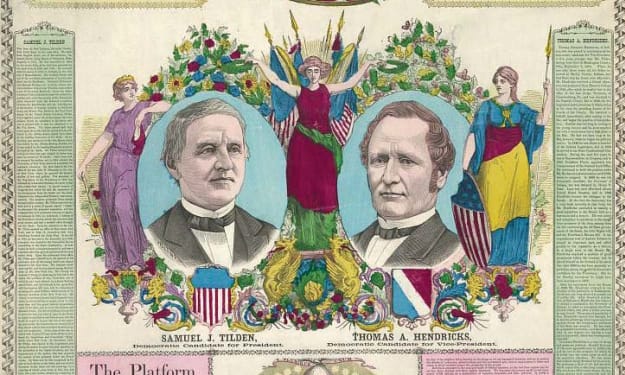
The Fifth in a series of 20 on the history of the Democratic Convention
1884: “Grover the Good” for President
Dates: July 8 - 11, 1884
Venue: The Interstate Exposition Building, Michigan and Adams. Stood from 1872 to 1892. Currently the site of the Art Institute of Chicago, one of the world’s premiere museums.
Events: New York Governor Grover Cleveland was the favorite, and he was elected fairly quickly, winning 683 ballots on the second go around. Thomas Bayard and Thomas Hendricks were also-rans. Hendricks, who many felt was cheated out of the vice presidency during the 1876 election, was given the Vice Presidential nod by delegates.
The 1884 convention was the first to have delegates from Washington DC and the western territories. The platform was relatively progressive, calling for fairer taxes and supporting the rights of organized labor (two years before Labor Day was started).
November: In a change of pace, voters chose Democrat Grover Cleveland after 25 years of Republican leaders. Cleveland won his home state of New York, but by only 1047 votes, and that led to victory over Janes Blaine of Maine, 219 to 182 electoral votes. It was by far one of the closest elections in US history. The popular vote was much closer, with Cleveland winning by only 60,000 votes out of 9.7 million cast.
Two key factors in New York were a gaffe by a Republican about “Rum, Romanism and Rebellion” that alienated Roman Catholic voters, and “Mugwumps” or reform Republicans who viewed Blaine as corrupt and Cleveland as a reformer.
1888: “Grover the Good” Gets Cheated
Dates: June 5 - 7, 1888
Venue: St Louis Exposition Building, corner of 13th and Olive, St Louis MO. The building stood from 1883 to 1907. It was torn down to make way for the St Louis Central Library, which is still there 112 years later.
Events: Incumbent President Grover Cleveland was nominated by acclamation, the first time that had happened at a Democratic convention in 48 years. Vice President Thomas Hendricks, after all the trouble he took getting there, died in office after only eight months on the job. Cleveland replaced him with former judge and Senator Allen Thurman.
The big issues in the 1888 platform were economic: tariff reductions and tax reform.
November 1888: Cleveland faced off against Benjamin Harrison, the grandson of William Henry Harrison. Cleveland actually won the popular vote by 90,000 votes (out of 11 million cast). Harrison captured New York by 15,000 votes, and with it, 36 critical electoral votes. Harrison beat Cleveland in the electoral college by 233 to 168. There was notorious fraud in the 1888 election, especially in New York and Harrison’s home state of Indiana.
1892: “Grover the Good” Gets Revenge
Dates: June 8 - 11, 1892
Venue: The Wigwam, Lake Park (Grant Park), Chicago. Political parties often used temporary structures for their conventions in the 19th century. In that politically incorrect age, they were known as “wigwams.”
Events: Grover Cleveland, seeking to make a comeback after his narrow 1888 loss, was the front runner, but he did face some opposition. Members of the Tammany ring from his home state of New York disliked Cleveland’s honesty. Cleveland did win on the first ballot, with 617 out of 910 ballots. Senator David Hill of New York and Senator Horace Boies of Iowa split most of the rest of the votes.
Adlai Stevenson, running as a favorite son, won the Vice Presidential nomination following shifts after the first ballot. He beat out Indiana Governor Isaac Gray, Cleveland’s choice. The 1892 platform was relatively progressive, calling for public education and child labor laws.
Chicago was in the process of building the Columbian Exposition and delegates were invited for a sneak preview before it opened in October.
The 1892 convention was not the most pleasant of experiences, as it was stormy most of the week and the roof of the Wigwam leaked.
The 1892 platform called for a canal in Nicaragua, stronger anti-trust laws and financial aid for public education.
November 1892: In a rematch with Harrison, Cleveland whomped the Republican 277 to 145 in the electoral college and won by almost 400,000 in the popular vote. Populist candidate James Weaver won four states and 22 electoral votes in the west. Cleveland retook New York by 45,000 votes, a key victory along with Illinois.






Comments
There are no comments for this story
Be the first to respond and start the conversation.